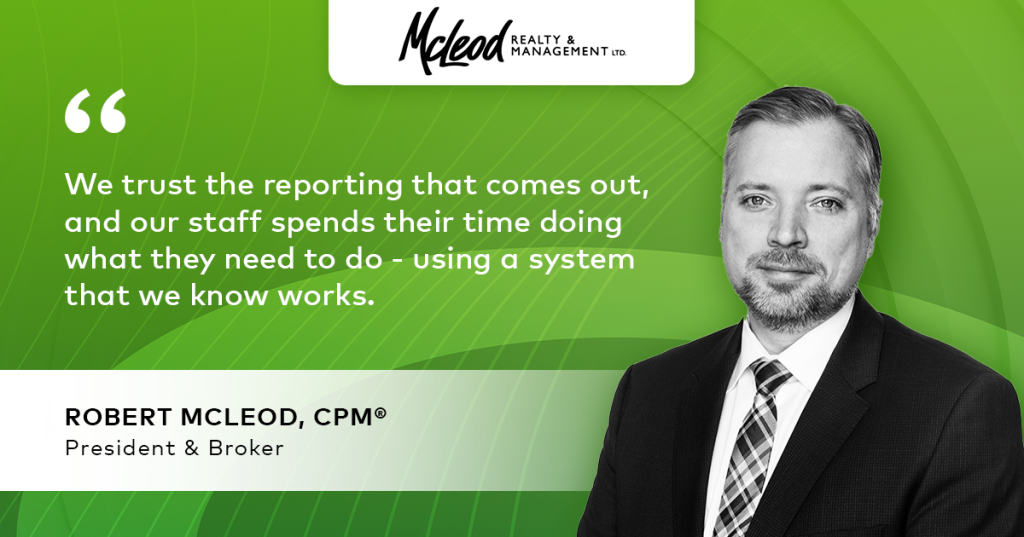While we don’t know what the post-pandemic future holds (or even when it will arrive), we know that social distancing at work is here to stay as long as the coronavirus and COVID-19 are with us.
Some property management offices can let their staff work remotely, which is often the safest option and may be for some time. Still, as businesses reopen and people return to work, it’s important to have social distancing measures in place to keep people as safe as possible. Here are some ways property managers can make the slow transition back to in-office or onsite work safer.

1. Limit visitors to your offices
It might be nice to have the family pop in for a surprise visit or to have lunch with a friend, but it’s probably time to rethink an open visitation policy. As long as there’s a health concern due to the pandemic, it might not be the best time to let visitors step into your offices.
BUT WHAT ABOUT ESSENTIAL VISITORS?
Of course, not every walk-in is a social call. Prospects may be popping in for a tour, and residents may have questions. While prospects and residents are obviously essential to your business, they don’t necessarily need to come into your office. Instead, meet them outside, make sure all parties have facemasks and maintain a minimum distance of six feet apart. Social distancing at work might seem awkward, but it shows everyone — staff, residents and prospects — that you make health and safety a priority.
2. Send emails, make calls or hold virtual meetings when possible
If you need to relay important information, rather than an in-person meeting, it may be possible to simply pick up the phone, send an email or have your staff join you via Zoom, GoToMeeting or another virtual meeting app. Still, sometimes it’s easier to have a conversation or brainstorm session when you can see people’s faces (in-person, not virtually). If your message won’t be lost via email or over the phone, there’s probably no reason to break social distancing at work just to get a point across.
3. Stagger work-from-home and in-office days
If it’s possible to let some employees work from home, you may be able to carry such a policy forward indefinitely. But some tasks and meetings are better done in-person, and we never want to lose the human connection with coworkers and residents. Try to stagger days that some employees work from home, perhaps reducing office occupancy to 50-75% at any given time.
That means Bob and Linda might work from home on Mondays and Fridays, while George and Diane work from home Tuesdays, Wednesdays and Thursdays. That’s a very specific example, but it’s one way to manage social distancing at work.
4. Add barriers between desks
Social distancing at work is going to look different from office to office, state to state, etc. There’s no one way to do it. Here are a few quick ideas to improve social distancing for workspaces:
- Reorganize the space, moving all desks at least six feet apart
- Put cubicle walls between desks
- Add see-through barriers between desks
- Reduce the number of people allowed in one area
5. Wear face coverings at appropriate times
If we had to wear face coverings at all times at work, we’d probably have a good argument for not returning to the office. In fact, as long as society is wearing masks and you have the ability to operate remotely, it might be safest to keep your building closed down and let your staff work from home.
Still, many businesses are reopening, and face masks are likely to be around until there’s a vaccine for COVID-19. To protect your team and community, consider a mask-wearing policy at your office when entering or leaving the building, meeting residents or stepping away from your desk to get coffee, refill water bottles, etc.
PRO TIP TO PREVENT THE SPREAD OF GERMS
Use hand sanitizer or wash your hands whenever putting on or removing a mask. Avoid touching your face or the mask when it is on. Also, if you need to scratch your face (some masks can get a bit itchy) use hand sanitizer or wash your hands immediately.
6. Stop shaking hands with prospects, tenants and your own team
Hand-shaking is an ancient practice, one that symbolically and literally connects two people in a warm but socially permissible embrace. It has been used to solidify promises, greet strangers for the first time and even say goodbye at social gatherings. And now, maybe it’s time to say goodbye to the handshake forever.
The reason for stopping handshaking is probably obvious: Our hands come into contact with germs every time we touch something. We collect and potentially spread germs when we sneeze, touch our face, pick up our phones, etc. One of the simplest ways to practice social distancing at work and reduce the spread of germs, whether or not we’re in a health crisis like the coronavirus, is to stop touching other people’s hands.
So how will we greet people if we don’t shake hands? That remains to be seen. However, if we’re looking for inspiration, many cultures have been using the polite bow as a greeting for centuries.
7. Practice safe sneezing
Even when you’re healthy, you’re going to sneeze at work. If you have a tissue, sneeze into that, then wash your hands or apply hand sanitizer right away. If you’re suddenly overcome with a need to sneeze and don’t have any other choice, sneeze directly into your elbow.
Going forward, it’s probably a good idea to wash your hands every time you sneeze. If you’re having a meeting or can’t realistically rush to the nearest bathroom, keep sanitizer around to use in a pinch.
And check out these tips on how to prevent cold and flu in multifamily residences.
8. Send sick people home
If you’re sick, stay home. If someone on your team comes in sneezing or coughing, politely ask them to take a sick day. There will be people who try to push through sickness, barely able to admit to themselves that they’re under the weather. It’s also possible they don’t want to use a sick day, vacation day or take unpaid time off.
Nonetheless, the first priority of any office is the health and safety of your staff and residents, so set the tone and send unwell team members home. If they’re feeling strong enough to work remotely, let them! This is a great way to practice social distancing at work without losing productivity.
9. Be prepared to be flexible
Unfortunately, social distancing at work may not be enough to prevent future outbreaks of the coronavirus. You may have to go back to a remote office work model if COVID-19 cases surge again.
Be prepared to scale up your remote capabilities and relax them again over time. Communicate this plan to your residents and staff so they’re ready when you have to switch gears. In general, people will probably be glad to hear that you’re doing your part to protect others during a global pandemic.
10. Use online software to stay efficient
If you’re going to streamline daily tasks and make it easier and safer for your team to work through this new normal, you need the right property management software. Yardi Breeze Premier works on any device, from anywhere, so it’s ideal for companies that need to get set up and running quickly for in-office or remote work.
We know social distancing at work is complicated, but Breeze Premier can save you time and money on virtually every aspect of the job. It’s not just something you want during a pandemic — online property management will be at the centre of your business operations for many years to come.



